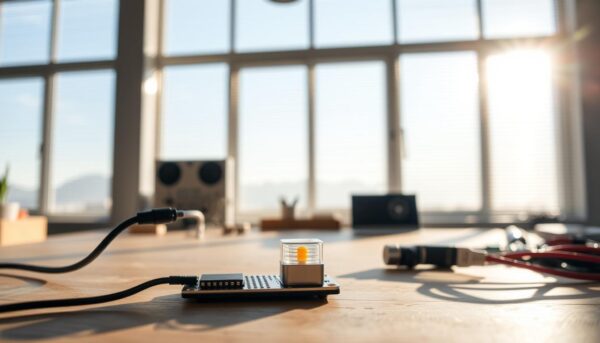✅ Last checked on
Imagine living in a space that adapts to natural light and heat without manual adjustments. How much energy—and money—could you save by aligning your environment with the sun’s daily path? This guide explores practical ways to optimize indoor comfort while reducing reliance on traditional power sources.
Harnessing renewable energy starts with understanding solar patterns. By tracking daylight movements, you can program devices like lights, window shades, and thermostats to respond automatically. For example, Arduino-powered sensors can adjust blinds as sunlight shifts, maintaining ideal temperatures year-round.
We’ll walk through both the science behind these systems and hands-on projects. You’ll learn how to calibrate sensors, assemble components, and choose between prebuilt solutions or DIY setups. Whether you’re tech-savvy or just starting out, this approach balances efficiency with simplicity.
Key Takeaways
- Automate lighting, shades, and climate control using solar patterns
- Reduce energy costs by aligning systems with natural light cycles
- Explore Arduino-based projects for customizable solutions
- Understand sensor calibration and system assembly basics
- Make informed choices when integrating automated features
Understanding smart home sun tracking automation
Efficient energy use begins with precise environmental awareness. Systems that adapt to daylight changes optimize resource consumption while maintaining comfort. Let’s break down how these technologies work and their practical advantages.
![]()
The Concept Behind Renewable Energy Alignment
Light-dependent resistors (LDRs) measure brightness levels across different areas. When paired with microcontrollers like Arduino, they detect shifts in light patterns. This data informs motorized components to rotate panels or adjust window shades automatically.
Solar panels generate electricity by absorbing photons from daylight. Proper alignment increases exposure, boosting output by up to 40% compared to fixed setups. Calibrating sensors ensures accurate responses to seasonal or weather-related variations.
Advantages of Dynamic Energy Solutions
Adaptive systems reduce reliance on grid power while lowering utility bills. They also extend device lifespans by preventing overheating or overuse. Here’s how fixed and tracking setups compare:
| Feature | Fixed System | Tracking System |
|---|---|---|
| Daily Power Output | 8-10 kWh | 12-14 kWh |
| Maintenance Needs | Low | Moderate |
| Initial Cost | $1,200 | $2,500 |
Residential users often see a 3-5 year payback period despite higher upfront costs. Industrial applications benefit from scalable designs for large installations. Explore tutorials to balance budget and performance for your needs.
Implementing Automation: Controlling Light, Blinds, and Temperature
Daylight patterns shape your indoor experience more than you might realize. Morning rays heat east-facing rooms, while afternoon glare demands shade adjustments. These natural shifts create opportunities to optimize comfort through responsive technology.

How Light Intensity Guides Adjustments
Brightness levels directly affect thermostat demands and blind positions. South-facing windows may require 60% shade closure during peak hours to prevent overheating. Use light-dependent resistors (LDRs) to measure these fluctuations:
- Mount sensors near windows at 45° angles
- Test readings across dawn, noon, and dusk
- Compare values against HVAC performance data
“Proper calibration turns raw data into actionable commands. A 900-lux reading could trigger 50% blind closure while lowering AC output by 30%.”
Programming Precision Responses
Connect sensors to microcontrollers using this basic Arduino setup:
void loop() {
int sensorValue = analogRead(A0);
if (sensorValue > 700) {
digitalWrite(blindMotor, HIGH);
digitalWrite(lightSwitch, LOW);
}
}
Consider these factors when scheduling adjustments:
| Condition | Blind Position | Light Level |
|---|---|---|
| Overcast | 25% open | 75% brightness |
| Direct light | Closed | Off |
| Twilight | Open | 40% brightness |
Test configurations weekly during different weather patterns. Fine-tune thresholds until your space maintains consistent comfort with minimal manual input.
Building Your Solar Tracker: A Step-by-Step How-To
Constructing a responsive energy solution requires careful planning and precise execution. Follow this guide to assemble a functional prototype that adapts to daylight changes efficiently.
Gathering Components and Setting Up Your Arduino Project
Start with these essential parts:
| Component | Purpose | Quantity |
|---|---|---|
| Arduino Uno | Control center | 1 |
| LDR sensors | Light detection | 4 |
| SG90 servo motor | Panel rotation | 2 |
| 10kΩ resistors | Voltage regulation | 4 |
For detailed specs, refer to this step-by-step Arduino solar tracker guide.
Wiring and Sensor Placement Strategies
Connect components using this configuration:
| Arduino Pin | Connected To | Wire Color |
|---|---|---|
| A0-A3 | LDR sensors | Yellow |
| D9-D10 | Servo motors | Orange |
| 5V | Resistor network | Red |
Mount sensors 2″ apart at the panel’s edges. This spacing helps detect directional light shifts accurately.
Programming and Calibration Techniques
Upload this basic code to test responsiveness:
#include <Servo.h>
Servo horizontalServo;
void setup() {
horizontalServo.attach(9);
}
void loop() {
int eastLDR = analogRead(A0);
int westLDR = analogRead(A1);
if(eastLDR > westLDR + 50) {
horizontalServo.write(horizontalServo.read() - 5);
}
}
Test at three times: morning, noon, and late afternoon. Adjust sensitivity thresholds until movements align with actual light changes.
Conclusion
Creating an energy-efficient environment starts with intelligent design. By combining sensors, microcontrollers, and responsive hardware, you can build systems that adapt to natural light cycles. This approach reduces wasted power while maintaining comfort through precise adjustments.
Your project’s success hinges on careful assembly and calibration. Components like Arduino boards, LDR sensors, and servo motors work together to detect shifts in brightness. Proper wiring and coding ensure panels or shades respond accurately to changing conditions.
Automatic adjustments boost efficiency by 30-40% compared to static setups. While initial costs vary, long-term savings justify the investment for many households. Test your system across seasons to refine its performance.
Ready to take control of your energy use? Start with small-scale prototypes before expanding. Every step—from sensor placement to code tweaks—teaches valuable skills for optimizing renewable resources. Your journey toward sustainable living begins here.